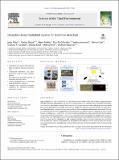Files in this item
Honeybee-based biohybrid system for landmine detection
Item metadata
| dc.contributor.author | Filipi, Janja | |
| dc.contributor.author | Stojnić, Vladan | |
| dc.contributor.author | Muštra, Mario | |
| dc.contributor.author | Gillanders, Ross N. | |
| dc.contributor.author | Jovanović, Vedran | |
| dc.contributor.author | Gajić, Slavica | |
| dc.contributor.author | Turnbull, Graham A. | |
| dc.contributor.author | Babić, Zdenka | |
| dc.contributor.author | Kezić, Nikola | |
| dc.contributor.author | Risojević, Vladimir | |
| dc.date.accessioned | 2021-09-13T16:30:11Z | |
| dc.date.available | 2021-09-13T16:30:11Z | |
| dc.date.issued | 2022-01-10 | |
| dc.identifier | 275857966 | |
| dc.identifier | b429acd1-48ea-454e-8110-53d563e88667 | |
| dc.identifier | 85114315262 | |
| dc.identifier | 000701971500003 | |
| dc.identifier.citation | Filipi , J , Stojnić , V , Muštra , M , Gillanders , R N , Jovanović , V , Gajić , S , Turnbull , G A , Babić , Z , Kezić , N & Risojević , V 2022 , ' Honeybee-based biohybrid system for landmine detection ' , Science of the Total Environment , vol. 803 , 150041 . https://doi.org/10.1016/j.scitotenv.2021.150041 | en |
| dc.identifier.issn | 0048-9697 | |
| dc.identifier.other | RIS: urn:1F48636CD941CC340511228BC3F65812 | |
| dc.identifier.other | ORCID: /0000-0002-8825-3234/work/100172693 | |
| dc.identifier.uri | https://hdl.handle.net/10023/23955 | |
| dc.description | This research was funded in part by NATO Science for Peace and Security (SPS) Programme, project number SPS 985355, “Biological Method (Bees) for Explosive Detection”. | en |
| dc.description.abstract | Legacy landmines in post-conflict areas are a non-discriminatory lethal hazard and can still be triggered decades after the conflict has ended. Efforts to detect these explosive devices are expensive, time-consuming, and dangerous to humans and animals involved. While methods such as metal detectors and sniffer dogs have successfully been used in humanitarian demining, more tools are required for both site surveying and accurate mine detection. Honeybees have emerged in recent years as efficient bioaccumulation and biomonitoring animals. The system reported here uses two complementary landmine detection methods: passive sampling and active search. Passive sampling aims to confirm the presence of explosive materials in a mine-suspected area by the analysis of explosive material brought back to the colony on honeybee bodies returning from foraging trips. Analysis is performed by light-emitting chemical sensors detecting explosives thermally desorbed from a preconcentrator strip. The active search is intended to be able to pinpoint the place where individual landmines are most likely to be present. Used together, both methods are anticipated to be useful in an end-to-end process for area surveying, suspected hazardous area reduction, and post-clearing internal and external quality control in humanitarian demining. | |
| dc.format.extent | 9 | |
| dc.format.extent | 3112323 | |
| dc.language.iso | eng | |
| dc.relation.ispartof | Science of the Total Environment | en |
| dc.subject | REST sampling | en |
| dc.subject | Organic semiconductors | en |
| dc.subject | Unmanned aerial vehicles | en |
| dc.subject | Convolutional neural networks | en |
| dc.subject | Humanitarian demining | en |
| dc.subject | QC Physics | en |
| dc.subject | DAS | en |
| dc.subject.lcc | QC | en |
| dc.title | Honeybee-based biohybrid system for landmine detection | en |
| dc.type | Journal article | en |
| dc.contributor.institution | University of St Andrews. School of Physics and Astronomy | en |
| dc.contributor.institution | University of St Andrews. Sir James Mackenzie Institute for Early Diagnosis | en |
| dc.contributor.institution | University of St Andrews. Centre for Biophotonics | en |
| dc.identifier.doi | https://doi.org/10.1016/j.scitotenv.2021.150041 | |
| dc.description.status | Peer reviewed | en |
This item appears in the following Collection(s)
Items in the St Andrews Research Repository are protected by copyright, with all rights reserved, unless otherwise indicated.

